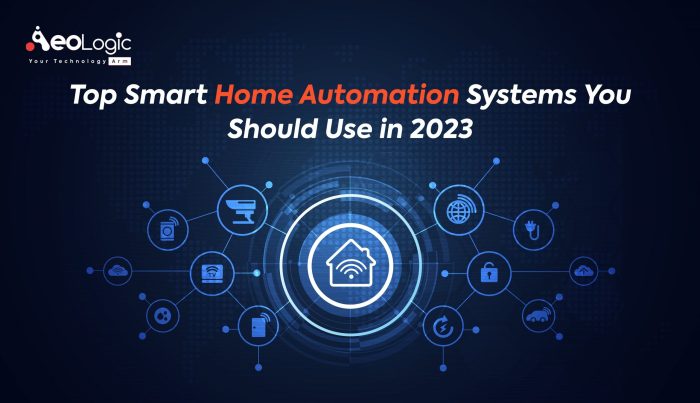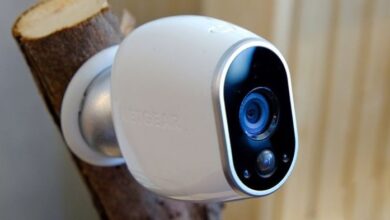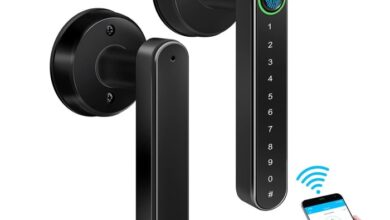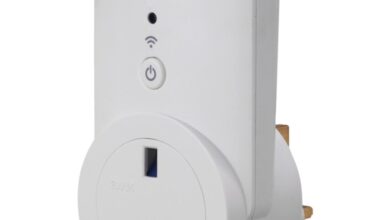Home Automation Systems A Smart Home Guide
Home Automation Systems are transforming how we live, offering seamless control over our homes through technology. Imagine a world where your lights dim automatically at sunset, your thermostat adjusts to your preferences, and your security system alerts you of any unusual activity – all without lifting a finger. This isn’t science fiction; it’s the reality of smart homes, and this guide will delve into the fascinating world of home automation, exploring its components, benefits, challenges, and future potential.
We’ll uncover the secrets behind making your house truly smart, examining everything from the latest devices and integration techniques to crucial security considerations and cost-effective solutions.
From understanding the core components of a typical system to navigating the complexities of interoperability between different smart home devices and platforms, we’ll provide a comprehensive overview. We’ll also explore the ethical implications of data collection, offer practical installation advice, and showcase advanced features like voice control and geofencing. Get ready to unlock the power of a truly connected home.
Defining Home Automation Systems
Home automation, also known as smart home technology, represents a significant leap in convenience and efficiency for modern living. It’s the integration of various technologies to automate home functions, creating a more comfortable, secure, and energy-efficient environment. This interconnected ecosystem allows for remote control and monitoring of numerous aspects of a home, from lighting and temperature to security and entertainment.
Understanding its core components and different architectures is crucial to appreciating its potential and limitations.Home automation systems are built upon a foundation of interconnected devices and a central control system. These systems typically include sensors, actuators, a control unit (often a hub or gateway), and a user interface (like a smartphone app or touchscreen panel). Sensors gather data about the home environment—temperature, light levels, door/window status, etc.—while actuators execute actions based on this data or user commands.
The control unit acts as the brain, processing information from sensors and directing actuators accordingly. The user interface allows homeowners to interact with and manage the entire system.
Core Components of Home Automation Systems
A typical home automation system comprises several essential elements working in concert. These elements, while varying in specifics based on the system’s complexity and manufacturer, generally include a network infrastructure (wired or wireless), a central control unit (hub or gateway), various sensors (motion, temperature, light, etc.), and actuators (lights, thermostats, locks, appliances, etc.). Furthermore, a user interface (UI) is paramount, enabling easy interaction and system management through smartphones, tablets, or dedicated control panels.
The seamless integration of these components is key to a functional and user-friendly smart home experience. For example, a motion sensor might trigger lights to turn on automatically, illustrating the interplay between sensing and actuation.
Types of Home Automation Systems Based on Technology
Home automation systems utilize diverse technologies, each with its own strengths and weaknesses. Z-Wave, Zigbee, and Wi-Fi are among the most prevalent wireless communication protocols. Z-Wave offers robust security and long-range capabilities, ideal for larger homes. Zigbee, known for its low power consumption, is well-suited for battery-powered devices. Wi-Fi, despite its wider range, can be more susceptible to interference and security vulnerabilities.
Wired systems, using Ethernet or powerline communication, offer higher bandwidth and reliability but require more complex installation. The choice of technology depends on factors like home size, budget, and desired level of sophistication. Consider a scenario where a large home might benefit from a Z-Wave system for its range and security, while a smaller apartment might find Zigbee sufficient.
Benefits and Drawbacks of Home Automation System Architectures
The architecture of a home automation system significantly influences its performance, scalability, and cost. Centralized systems, where a single hub controls all devices, offer simplicity and ease of management. However, they can be vulnerable to single points of failure. Decentralized systems, on the other hand, distribute control among multiple hubs or devices, enhancing resilience but potentially increasing complexity.
Cloud-based systems offer remote accessibility and advanced features but raise concerns about data privacy and reliance on internet connectivity. Local systems, operating independently of the cloud, prioritize privacy and reliability but might lack some of the advanced features of cloud-based systems. The optimal architecture depends on individual priorities and risk tolerance. For instance, a user prioritizing security might opt for a local system, while someone valuing remote access might choose a cloud-based solution.
Smart Home Devices and Integration
The allure of a seamlessly connected home, where lights dim automatically, thermostats adjust to your preferences, and appliances respond to voice commands, is undeniable. But the reality of achieving this utopian smart home often involves navigating a complex landscape of devices, protocols, and platforms, each with its own quirks and limitations. Understanding the intricacies of smart home device integration is crucial for anyone looking to build a truly effective and efficient system.
Interoperability Challenges in Smart Home Ecosystems
Achieving seamless interoperability between different smart home devices and platforms remains a significant hurdle. Many devices rely on proprietary protocols, creating “siloed” ecosystems where devices from different brands struggle to communicate effectively. For instance, a smart light bulb from one manufacturer might work flawlessly with its own smart hub but refuse to integrate with a different brand’s smart speaker or home automation system.
This fragmentation limits flexibility and hinders the creation of truly unified smart home experiences. Overcoming these challenges requires industry-wide adoption of open standards and greater collaboration among manufacturers. This is an ongoing effort, with varying degrees of success. For example, Matter, a new standard, is attempting to address this issue, but full adoption will take time.
Comparison of Popular Smart Home Device Brands and Ecosystems
The smart home market is populated by a diverse range of brands, each offering its unique ecosystem of devices and services. Amazon’s Alexa, Google Home, and Apple HomeKit are prominent examples, each boasting extensive device compatibility within their respective platforms but often limited interoperability between them. Consider the difference between a Philips Hue smart lighting system integrated with an Amazon Echo versus the same system trying to integrate with a Google Nest Hub.
The former would offer a smooth, voice-controlled experience, while the latter might require workarounds or might not even be possible. Similarly, Samsung SmartThings and other platforms have their own strengths and weaknesses in terms of device support, app functionality, and overall user experience. The optimal choice depends heavily on individual needs and preferences, requiring careful consideration of compatibility with existing devices and future expansion plans.
Key Protocols and Standards for Home Automation Communication
Several protocols facilitate communication between smart home devices. Wi-Fi, while ubiquitous, can be power-intensive and susceptible to interference. Zigbee and Z-Wave, on the other hand, are low-power, mesh networking protocols designed specifically for home automation, offering better range and reliability in many situations. Each protocol has its advantages and disadvantages. Zigbee, for example, is known for its relatively low cost and ease of use, while Z-Wave often boasts superior range and security features.
Understanding these differences is essential for choosing the right devices and hubs for your smart home setup. The best protocol often depends on the specific application and the scale of your home automation system. A small setup might thrive on Wi-Fi, while a larger, more complex system might benefit from the efficiency and range of Zigbee or Z-Wave.
Comparison of Popular Smart Home Hubs
| Hub | Supported Protocols | Key Features | Approximate Price (USD) |
|---|---|---|---|
| Amazon Echo (4th Gen) | Wi-Fi, Bluetooth, Zigbee | Voice control, smart home hub functionality, music playback | $99 |
| Google Nest Hub (2nd Gen) | Wi-Fi, Bluetooth | Smart display, voice control, smart home hub functionality | $99 |
| Samsung SmartThings Hub | Wi-Fi, Zigbee, Z-Wave | Extensive device compatibility, robust automation features | $69 |
| HomeKit Hub (Apple TV or HomePod) | Wi-Fi, Bluetooth, Thread | Secure, tightly integrated with Apple ecosystem | Varies (depending on Apple TV or HomePod model) |
Security and Privacy Considerations: Home Automation Systems
The convenience and efficiency offered by home automation systems come with inherent security and privacy risks. Understanding these vulnerabilities and implementing robust security measures is crucial for protecting your home and personal data. Failing to do so could expose you to various threats, from minor inconveniences to significant financial and personal losses. This section details potential vulnerabilities and Artikels best practices for mitigating these risks.The interconnected nature of smart home devices creates a large attack surface.
A single compromised device can act as an entry point for attackers to gain access to your entire network. This could allow them to control other devices, steal personal information, or even monitor your activities. The sheer volume of data collected by these systems, from daily routines to personal preferences, makes effective security paramount. Consider the potential impact of a data breach – imagine an intruder gaining access to your security cameras or manipulating your smart locks.
Potential Security Vulnerabilities
Home automation systems are susceptible to various security threats. These range from simple password guessing attacks to sophisticated exploits targeting software vulnerabilities in devices or the network infrastructure itself. Weak or default passwords are a common entry point for attackers, while outdated firmware can leave devices vulnerable to known exploits. Furthermore, unsecured Wi-Fi networks can expose your entire smart home ecosystem to unauthorized access.
A lack of robust encryption protocols can also leave data vulnerable to interception. For example, an attacker could potentially intercept unencrypted communications between a smart thermostat and a central control system to gain unauthorized access to your heating schedule, compromising both comfort and security.
Best Practices for Securing a Home Automation Network
Securing your home automation network requires a multi-layered approach. This starts with choosing strong, unique passwords for each device and regularly updating firmware to patch security vulnerabilities. Using a strong, password-protected router is also essential, as is enabling encryption protocols like WPA2 or WPA3. Consider segmenting your network, separating your smart home devices from other devices like computers and laptops.
This limits the damage if one device is compromised. Regularly review the security settings of your devices and apps, ensuring that only necessary features are enabled. Two-factor authentication, whenever available, should be enabled to add an extra layer of protection. Finally, be mindful of the apps you grant access to your smart home data, opting for reputable providers with a strong security track record.
Think of it as a fortress with multiple gates, each requiring its own strong key and regular inspection.
Ethical Implications of Data Collection
Home automation companies collect vast amounts of data about user behavior and preferences. The ethical implications of this data collection and usage are significant. Transparency regarding data collection practices is crucial, along with clear explanations of how this data is used, stored, and protected. Users should have control over their data, with the ability to access, modify, or delete it.
Concerns about potential biases in algorithms, data security breaches, and the potential for misuse of data for targeted advertising or other purposes need careful consideration. For instance, the collection of data on energy consumption could be used to identify patterns and improve efficiency, but also potentially used for targeted advertising based on lifestyle inferences. A responsible approach necessitates robust data protection policies and ethical guidelines.
Home Automation System Installation and Setup
Setting up a home automation system can seem daunting, but with a methodical approach, it’s a manageable project that can dramatically improve your home’s comfort and convenience. This guide provides a step-by-step process for a basic setup, along with troubleshooting tips to help you navigate any potential hurdles. Remember, the complexity of your system will depend on your needs and the number of smart devices you choose to integrate.
Basic Home Automation System Setup
This section details the process of installing a fundamental home automation system, focusing on core components and essential steps. A successful installation hinges on careful planning and a clear understanding of your network infrastructure. Begin by choosing a central hub, often a smart home assistant like Amazon Alexa or Google Home, which will serve as the brain of your system.
- Choose a Smart Home Hub: Select a hub compatible with the devices you intend to use. Consider factors such as voice control capabilities, app interface, and integration with other platforms.
- Install the Hub: Place the hub in a central location with a strong Wi-Fi signal. Follow the manufacturer’s instructions for setup, which typically involve plugging it in, connecting it to your Wi-Fi network, and downloading the accompanying app.
- Add Smart Devices: Begin with a few key devices, such as smart lights and a smart thermostat. Each device will require its own setup process, often involving downloading a specific app and following the manufacturer’s instructions for pairing it with your hub. This may involve scanning QR codes or entering unique device IDs.
- Configure Device Settings: Customize each device’s settings within the app. This includes naming devices, setting schedules, and adjusting brightness or temperature preferences. Take advantage of features like automation routines, such as automatically turning off lights at a specific time or adjusting the thermostat based on occupancy.
- Test and Refine: Thoroughly test your system to ensure all devices are functioning correctly and communicating with the hub. Experiment with different automation routines and make adjustments as needed to optimize your setup for maximum efficiency and convenience.
Troubleshooting Common Installation Problems
Connectivity issues, device incompatibility, and app malfunctions are common challenges. Addressing these problems requires systematic troubleshooting, often involving checking network settings, device power, and app updates. Many issues can be resolved by restarting devices, checking for firmware updates, or verifying network connectivity.
- Weak Wi-Fi Signal: A weak Wi-Fi signal is a frequent culprit. Use a Wi-Fi analyzer app to identify areas with poor coverage and consider using a Wi-Fi extender or mesh network to improve signal strength.
- Device Incompatibility: Ensure all your devices are compatible with your chosen hub. Check the manufacturer’s websites for compatibility lists. Some devices might require specific firmware versions to work optimally.
- App Glitches: App malfunctions can occur. Try force-closing the app, restarting your phone or tablet, and checking for app updates. If the problem persists, contact the app’s support team.
- Network Configuration Issues: Double-check your router’s settings, ensuring that your home automation hub and devices are on the same network and have the necessary ports open. Consult your router’s manual if needed.
Simple Home Automation Setup for a New House
Designing a home automation system for a new house offers the advantage of planning for integration from the outset. Consider the following device selection and network configuration to create a functional and user-friendly system.For a new home, start with a robust Wi-Fi network infrastructure, perhaps using a mesh system for optimal coverage. This ensures reliable connectivity for all your smart devices.
Prioritize smart lighting, a smart thermostat, and smart locks for enhanced security and convenience. Adding smart speakers for voice control further enhances the system’s usability. A smart security system, integrating cameras and sensors, adds an extra layer of protection. The specific brands and models chosen will depend on your budget and personal preferences, but focusing on compatibility within a single ecosystem (e.g., Google Home or Amazon Alexa) simplifies setup and management.
For instance, a Philips Hue lighting system works seamlessly with Google Home, offering easy voice control and automated lighting schedules. Similarly, a Nest thermostat integrates well with Google Home, enabling voice-controlled temperature adjustments. Careful planning during the construction phase can simplify the installation of in-wall wiring for devices requiring hardwired connections.
Advanced Applications and Features
Stepping beyond the basics, advanced home automation unlocks a level of convenience and control previously relegated to science fiction. These features transform your home from a collection of smart devices into a truly integrated and responsive ecosystem, adapting to your lifestyle and anticipating your needs. This section explores the functionalities and practical applications of these advanced capabilities, enabling you to maximize the potential of your smart home investment.
Voice Control
Voice control, powered by virtual assistants like Amazon Alexa or Google Assistant, represents a significant leap forward in home automation accessibility. Instead of navigating apps or tapping interfaces, you can command your smart home with simple voice commands. This includes controlling lighting, adjusting thermostats, playing music, and even initiating complex automations. For instance, saying “Alexa, goodnight” could trigger a sequence of actions: dimming the lights, locking the doors, setting the thermostat, and arming the security system.
The convenience and intuitive nature of voice control significantly enhance the user experience, making smart home technology accessible to a broader audience. The seamless integration of voice commands into everyday routines is transforming how we interact with our homes.
Geofencing
Geofencing leverages GPS technology to create virtual boundaries around your home. When your smartphone (or other designated device) enters or exits this defined area, pre-programmed actions are triggered. This allows for automated responses based on your location. For example, geofencing could automatically disarm the security system upon your arrival home, turn on the lights, and adjust the thermostat to a comfortable temperature.
Conversely, upon leaving, the system could automatically lock the doors, arm the security system, and turn off unnecessary lights and appliances, maximizing energy efficiency and security. The ability to automate actions based on location offers a level of proactive control that significantly enhances both convenience and security. Think of it as your home anticipating your needs before you even arrive.
Scene Automation
Scene automation allows you to group multiple smart devices into pre-defined “scenes” that can be activated with a single command or trigger. This enables the creation of customized environments tailored to specific activities or times of day. For example, a “Movie Night” scene might dim the lights, draw the curtains, turn on the television, and start the sound system.
Similarly, a “Wake Up” scene could gradually brighten the lights, play your favorite music, and adjust the thermostat. The flexibility to create custom scenes allows for unparalleled personalization, transforming your home into a dynamic environment that perfectly matches your lifestyle and preferences. The possibilities are truly limitless, creating a customized home experience that is both comfortable and efficient.
Custom Automation Creation
Popular home automation platforms like Home Assistant, SmartThings, and IFTTT provide robust tools for creating custom automations. These platforms allow you to define triggers (events that initiate an automation, such as time of day, location, or device status) and actions (the responses to the trigger, such as turning on a light or sending a notification). For example, you could create an automation that turns on the porch light at sunset every day, or sends you a notification if a door or window is left open.
The ability to build personalized automations significantly extends the functionality of your smart home system, allowing you to tailor it to your unique needs and preferences. This level of control empowers users to create a truly personalized and efficient smart home environment.
- Voice Control: Hands-free operation of lights, thermostat, entertainment systems, and more. Imagine adjusting the room temperature simply by saying “Alexa, set the temperature to 72 degrees.”
- Geofencing: Automated actions triggered by entering or leaving a designated area. For instance, automatically unlocking your smart lock as you approach your home.
- Scene Automation: Grouping multiple devices into pre-defined scenes for easy control. A “Party Mode” scene could simultaneously adjust lighting, music, and temperature.
- Smart Home Monitoring: Real-time monitoring of energy consumption, security systems, and appliance status through a central dashboard. A visual representation of your home’s energy usage allows for better management and cost savings.
- Remote Access and Control: Managing your smart home remotely via smartphone or tablet, regardless of location. Check on your home’s security and adjust settings even while on vacation.
Future Trends in Home Automation
The home automation landscape is poised for a dramatic transformation, driven by converging technological advancements and evolving consumer expectations. We’re moving beyond simple smart devices towards a truly interconnected and anticipatory home environment, capable of learning user preferences and adapting to their needs proactively. This shift will be fueled by breakthroughs in artificial intelligence, the Internet of Things (IoT), and edge computing, creating both exciting opportunities and significant challenges for the industry.Emerging technologies like AI, IoT, and edge computing are reshaping the home automation landscape.
These advancements will lead to more personalized, responsive, and secure smart homes. The convergence of these technologies promises a future where homes are not just automated, but truly intelligent and adaptive.
Artificial Intelligence and Machine Learning in Home Automation
AI and machine learning are pivotal in creating truly intelligent homes. Instead of relying solely on pre-programmed rules, these systems learn user habits and preferences over time. For instance, a smart thermostat equipped with AI could learn the ideal temperature for each family member at different times of day and adjust accordingly, optimizing energy efficiency while ensuring comfort. This extends beyond temperature control; AI-powered systems can manage lighting, security, and entertainment based on learned behaviors and contextual factors.
Imagine a home that anticipates your arrival, adjusting lighting and temperature to your preferences before you even step inside. Companies like Google and Amazon are already integrating these technologies into their smart home ecosystems, offering glimpses into this future.
The Expanding Internet of Things (IoT) and its Impact, Home Automation Systems
The ever-expanding IoT is a core driver of home automation growth. The increasing number of interconnected devices—from appliances and lighting to security systems and entertainment hubs—creates a rich data ecosystem that fuels the development of sophisticated automation solutions. However, this expansion also presents challenges, primarily concerning data security and interoperability. Ensuring seamless communication between different devices and brands remains a crucial hurdle.
The development of standardized communication protocols is vital to unlock the full potential of the IoT in home automation. Consider the example of a smart refrigerator that automatically reorders groceries based on consumption patterns, or a smart sprinkler system that adjusts watering schedules based on weather forecasts and soil moisture sensors. These interconnected systems are already becoming more commonplace.
Edge Computing and Enhanced Home Automation Security
Edge computing is becoming increasingly important for enhancing the security and responsiveness of home automation systems. By processing data locally on devices within the home network, instead of relying solely on cloud-based servers, edge computing reduces latency and improves privacy. This is particularly crucial for security applications, where immediate responses are essential. Moreover, edge computing minimizes the reliance on internet connectivity, ensuring functionality even during outages.
Imagine a smart security system that can identify and respond to threats even without an active internet connection, relying on local processing power and stored data. This represents a significant leap forward in terms of security and reliability.
A Futuristic Smart Home Environment: A Visual Description
Imagine a home seamlessly integrated with its environment. Sunlight streams through smart windows that automatically adjust tint based on the time of day and weather conditions, optimizing natural light and energy efficiency. AI-powered assistants anticipate needs, proactively adjusting lighting, temperature, and entertainment based on the occupants’ schedules and preferences. A smart kitchen seamlessly manages food inventory, ordering groceries automatically as needed.
Security systems utilize facial recognition and advanced sensor technology, providing real-time monitoring and personalized alerts. The entire home operates with exceptional energy efficiency, learning from user habits to optimize consumption. The system is not just reactive; it anticipates and adapts to the needs of its inhabitants, creating a truly personalized and comfortable living space. This is a glimpse of the potential of future home automation.
Cost and Affordability of Home Automation
Stepping into the world of smart homes often evokes images of futuristic luxury, but the reality is more nuanced. The cost of home automation can vary wildly, depending on your chosen system, the scale of your project, and your level of tech-savviness. Understanding this spectrum is crucial for making informed decisions and achieving a balance between smart home functionality and budget constraints.
This section will dissect the financial aspects of home automation, offering insights into cost comparisons and strategies for maximizing affordability.
Cost Comparison of Home Automation Systems and Components
The initial investment in a home automation system can range from a few hundred dollars for a basic starter kit to tens of thousands for a fully integrated, multi-room setup. Factors significantly impacting cost include the brand, the number of devices, the complexity of installation, and the level of professional assistance required. For instance, a simple smart lighting system using affordable Wi-Fi bulbs might cost significantly less than a comprehensive system incorporating smart thermostats, security cameras, and automated window shades, all controlled through a sophisticated central hub.
Furthermore, the choice between DIY installation and professional services will also play a major role in the overall expense. Professional installation often adds a considerable premium but can offer peace of mind and ensure seamless integration. Consider the cost of individual components: smart plugs might range from $15 to $50 each, while a high-end smart thermostat could cost over $200.
Strategies for Cost-Effective Home Automation
Building a smart home on a budget is entirely achievable. One key strategy is to prioritize essential features. Instead of automating every aspect of your home at once, focus on the areas that offer the greatest value and impact. For example, starting with smart lighting and a smart thermostat can yield significant energy savings relatively quickly. Another effective approach is to leverage readily available and affordable smart home devices.
Many reputable brands offer budget-friendly options without sacrificing quality or functionality. DIY installation can significantly reduce labor costs, although it requires technical aptitude and time investment. Taking advantage of sales, promotions, and bundle deals can also lead to substantial savings. Finally, gradual implementation allows you to spread out the financial burden over time, preventing a large upfront expenditure.
Long-Term Cost Savings with Home Automation Systems
While the initial investment in home automation can seem significant, the long-term benefits often outweigh the upfront costs. Energy efficiency is a primary driver of savings. Smart thermostats, for example, learn your preferences and adjust the temperature accordingly, reducing energy consumption and lowering utility bills. Similarly, smart lighting systems allow for automated switching and dimming, minimizing energy waste.
In terms of security, home automation systems can enhance safety and potentially reduce insurance premiums. Smart security cameras, door sensors, and alarm systems can deter potential intruders and provide early warning of threats. Moreover, remote monitoring and control features offer peace of mind, even when away from home. The cumulative effect of these savings can lead to a substantial return on investment over time.
Consider a household that reduces its energy bill by 15% annually through smart home technology; this can amount to significant savings over several years, easily offsetting the initial investment.
Conclusive Thoughts

Building a smart home is a journey, not a destination. While the initial setup might seem daunting, the long-term benefits – from enhanced convenience and security to significant energy savings – far outweigh the effort. As technology continues to evolve, so too will the capabilities of home automation systems. By understanding the fundamentals, addressing security concerns, and exploring the latest innovations, you can create a personalized smart home that enhances your lifestyle and reflects your unique needs.
Embrace the future of home living – it’s smarter than you think.









